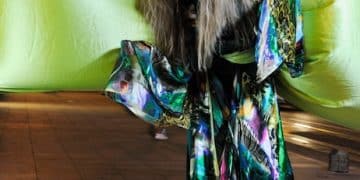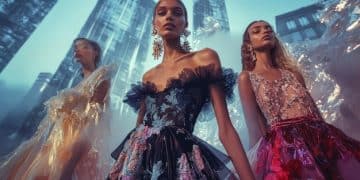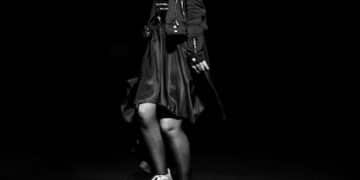The Influence of Music on Fashion: 2025 Trends by Artists

The influence of music on fashion is undeniable, especially as we look towards 2025. Artists are increasingly shaping trends, blending their auditory art with visual styles to create unique and influential statements.
The worlds of music and fashion have always been intertwined, but as we approach 2025, the relationship is becoming even more symbiotic. The influence of music on fashion is now more direct than ever, with artists acting as key trendsetters. How are these sonic innovators shaping what we’ll be wearing, and what are the key looks to watch out for?
From the streets to the runways, music’s impact can be seen everywhere. Let’s explore how musicians are not just creating the soundtracks to our lives, but also dictating our wardrobes in the coming years.
The Undeniable Connection: The Influence of Music on Fashion in 2025
The connection between music and fashion is deeply rooted in cultural expression. As we move closer to 2025, this bond is only strengthening, with artists becoming increasingly influential in setting fashion trends. The interplay between these two art forms creates a dynamic landscape where self-expression knows no bounds.
The influence extends beyond mere aesthetics; it encompasses lifestyle, attitude, and identity. Let’s delve further into how this influence manifests.
Genre-Specific Aesthetics
Each music genre carries its own distinct aesthetic, which often translates into fashion choices. Think about the evolution of hip-hop style from baggy jeans and oversized tees to high-end streetwear. Or consider the punk scene’s influence on deconstructed clothing and rebellious attitudes. These genre-specific aesthetics continue to evolve and inspire mainstream fashion.
Artist as Muse: Trendsetting in Action
Artists often serve as muses for designers, inspiring entire collections. Consider how Beyoncé’s “Lemonade” album influenced fashion with its Southern Gothic and African inspirations, or how Harry Styles’ gender-fluid style has pushed boundaries in menswear. These moments highlight the power of artists to shape fashion narratives.
- Hip-Hop’s Luxe Streetwear: Expect to see more high-end streetwear incorporating elements of classic hip-hop style with a futuristic twist.
- Electronic Music’s Cyberpunk Edge: Neon colors, tech-inspired accessories, and unconventional silhouettes will dominate electronic music-influenced fashion.
- Indie Rock’s Effortless Cool: A blend of vintage finds, minimalist designs, and comfortable fabrics will define the indie rock aesthetic.
- Pop’s Bold and Playful Statements: Bright colors, playful prints, and statement accessories will continue to be a hallmark of pop-inspired fashion.
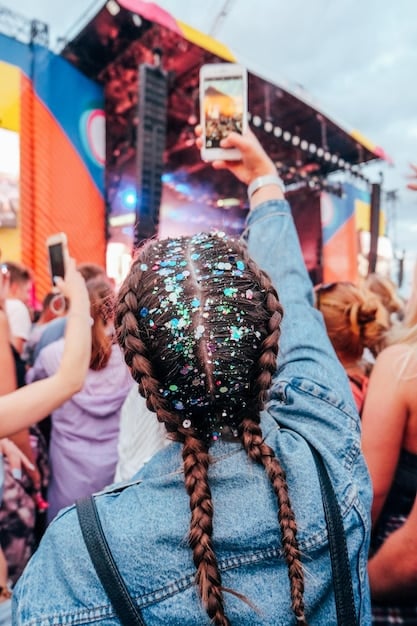
In conclusion, the interplay between music and fashion provides a rich tapestry of inspiration. Artists not only set trends but also reflect the mood and values of their audiences, creating a cyclical relationship that drives both industries forward.
Key Artists Shaping Fashion Trends in 2025
Identifying the artists who are actively shaping fashion trends is crucial to understanding the future landscape of style. These artists often collaborate with designers, launch their own fashion lines, or simply embody a unique aesthetic that resonates with their fanbase.
Let’s examine some pivotal figures and their impact on the fashion industry.
Rihanna: The Ultimate Style Chameleon
Rihanna has consistently proven herself to be a fashion icon, seamlessly transitioning between high fashion and streetwear. Her collaborations with brands like Puma and Fenty have disrupted the industry, promoting inclusivity and diversity. In 2025, expect to see more of her influence in athleisure and gender-neutral designs.
Harry Styles: Redefining Menswear
Harry Styles has challenged traditional menswear norms with his penchant for floral suits, sheer blouses, and painted nails. His influence has encouraged designers to experiment with fluidity and androgyny, pushing the boundaries of what is considered masculine. In 2025, his impact will likely extend to a broader acceptance of individual expression in menswear.
Billie Eilish: Comfort and Sustainability
Billie Eilish’s signature oversized clothing and commitment to sustainability have made her a role model for young people. Her focus on comfortable, eco-friendly fashion resonates with a generation increasingly concerned about environmental impact. Expect to see more sustainable and ethically sourced materials in mainstream fashion, partly due to her influence.
- Collaborations with Designers: Artists partnering with fashion houses to create limited-edition collections.
- Launch of Fashion Lines: Musicians launching their own clothing brands, reflecting their personal style and values.
- Embodying Unique Aesthetics: Artists who naturally embody a distinctive style that resonates with their fanbase and inspires designers.
Ultimately, these artists are not just wearing clothes; they are making statements. Their influence on fashion stems from their ability to connect with audiences on a deeper level, offering more than just aesthetic appeal.
The Rise of Digital Fashion and Virtual Concerts
The digital realm is increasingly influencing both music and fashion. Virtual concerts and digital fashion are becoming more prevalent, offering new avenues for artists and designers to connect and innovate. This shift is particularly relevant as we look towards 2025.
Virtual events blur the lines between the physical and digital worlds, creating unique opportunities for self-expression.
Digital Fashion: Dressing Your Avatar
Digital fashion involves clothing designed exclusively for virtual environments. Avatars can wear these digital garments in online games, social media, and virtual events. This trend allows for experimentation with bold, unconventional designs without the constraints of physical materials or production limitations. Expect to see more artists embracing digital fashion to express themselves in the virtual world.
Virtual Concerts: A New Stage for Style
Virtual concerts are transforming the way artists perform and connect with their fans. These events often feature elaborate stage designs, special effects, and unique digital avatars for the performers. Outfits worn in virtual concerts can be as extravagant and imaginative as the digital environment itself, pushing the boundaries of fashion expression.
The Metaverse as a Fashion Playground
The metaverse provides a platform for artists and fans to express themselves through fashion in entirely new ways. Digital wearables, virtual boutiques, and interactive fashion experiences are becoming increasingly common. Expect to see more artists collaborating with metaverse platforms to create immersive fashion experiences for their fans.
- NFT Fashion: Unique digital fashion items that can be bought, sold, and traded as non-fungible tokens.
- Augmented Reality (AR) Fashion: Digital clothing that can be “tried on” using AR technology over real-world images or videos.
- Virtual Influencers: Computer-generated personalities who wear and promote digital fashion, further blurring the lines between the real and virtual.
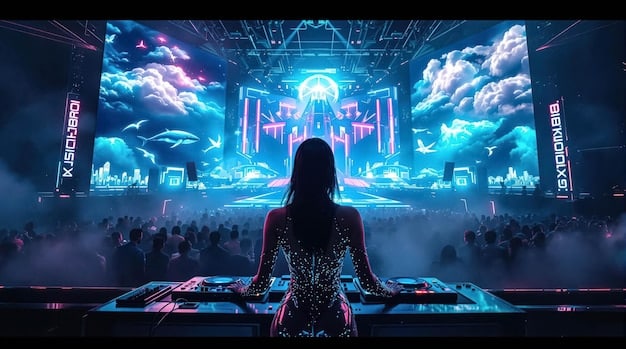
In conclusion, the digital revolution is opening up exciting new frontiers for the intersection of music and fashion. As virtual experiences become more sophisticated, expect to see even more innovative ways for artists to express their style and connect with their audience.
Sustainability and Ethical Fashion in Music-Inspired Trends
Sustainability and ethical practices are becoming increasingly important in the fashion industry, and music-inspired trends are no exception. Artists are using their platforms to promote eco-friendly and socially responsible choices, influencing fans to make more conscious fashion decisions. The convergence of music, fashion, and ethical consumerism is a powerful force for change.
Conscious consumerism is no longer a niche trend; it’s a mainstream movement that artists are actively supporting.
Eco-Friendly Materials and Production
Many artists are championing the use of sustainable materials like organic cotton, recycled polyester, and innovative alternatives like mushroom leather. They are also promoting ethical production practices that prioritize fair wages and safe working conditions. This commitment to sustainability is influencing designers and brands to adopt more responsible approaches.
Vintage and Upcycled Fashion
Vintage and upcycled fashion are gaining popularity, as consumers seek unique and sustainable alternatives to fast fashion. Artists are frequently seen wearing vintage pieces and promoting the concept of repurposing old clothing. This trend encourages consumers to embrace individuality while reducing their environmental impact.
Transparency and Traceability
Consumers are demanding more transparency in the fashion supply chain, wanting to know where their clothes come from and how they are made. Artists are using their influence to advocate for greater transparency and traceability, encouraging brands to disclose more information about their sourcing and production practices. This empowers consumers to make informed choices and support ethical brands.
- Organic Cotton and Hemp: Sustainable alternatives to conventional cotton that reduce water usage and pesticide exposure.
- Recycled Materials: Transforming waste materials like plastic bottles and fabric scraps into new clothing items.
- Plant-Based Dyes: Using natural dyes derived from plants to minimize the environmental impact of textile dyeing.
In summary, the intersection of music, fashion, and sustainability is driving meaningful change in the industry. Artists are using their influence to promote eco-friendly and ethical practices, inspiring fans to make more conscious fashion choices and demand greater transparency.
Predictions for Music and Fashion Trends in 2025
Looking ahead to 2025, several key trends are emerging at the intersection of music and fashion. From the continued rise of digital fashion to the increased focus on sustainability, the future promises to be both innovative and conscious.
These predictions are based on current trends and insights from industry experts.
Hyper-Personalization Through AI
Artificial intelligence (AI) will play a significant role in personalizing fashion experiences. AI-powered platforms will analyze individual preferences, body types, and style inspirations to create customized clothing designs and recommendations. Artists may collaborate with AI to develop unique fashion lines that cater to specific audience segments.
Gender-Fluid Fashion Takes Center Stage
Gender-fluid fashion will continue to gain momentum, blurring the lines between traditional menswear and womenswear. Artists will increasingly embrace non-binary styles, challenging conventional norms and inspiring fans to express themselves without limitations. Expect to see more unisex clothing lines and gender-neutral fashion campaigns.
Technological Integration in Apparel
Technology will be seamlessly integrated into clothing, enhancing both functionality and style. Smart fabrics, interactive designs, and wearable technology will become more prevalent. Artists may collaborate with tech companies to create innovative garments that respond to music, lighting, or environmental conditions.
- Smart Textiles: Fabrics embedded with sensors that monitor physiological data or change color based on mood.
- Interactive Designs: Clothing that responds to touch, sound, or movement.
- Wearable Technology: Integrating devices like smartwatches or headphones into clothing for seamless connectivity.
In conclusion, the future of music and fashion is poised to be dynamic and transformative. From AI-powered personalization to technological integration, the trends of 2025 promise to be innovative, inclusive, and sustainable.
| Key Point | Brief Description |
|---|---|
| 🎵 Genre-Specific Aesthetics | Music genres heavily influence specific fashion styles. |
| 🎤 Artists as Trendsetters | Musicians define future wardrobes, showcasing unique style. |
| 🌐 Rise of Digital Fashion | Virtual concerts and avatars spur new fashion forms. |
| ♻️ Sustainable Fashion | Eco-friendly and ethical practices drive conscious choices. |
Frequently Asked Questions
Artists influence fashion by collaborating with designers, launching their lines, embodying unique aesthetics, and expressing identity through their music and style choices.
Social media platforms amplify trends, allowing artists to connect with audiences and showcase their styles. This facilitates trends going viral.
Virtual concerts spur futuristic looks, while digital fashion enables experimentation without physical constraints. Both drive innovation in aesthetics and expression.
The trends will include eco-friendly materials, vintage and upcycled pieces, and brand transparency. Consumers will demand ethical production practices.
AI will personalize style, gender-fluid designs will dominate, and smart textiles will enhance functionality. These drive fashion toward personalized, inclusive designs.
Conclusion
In conclusion, the influence of music on fashion is set to become even more profound in 2025. Artists will continue to shape trends, and digital innovations and sustainability practices will redefine industry standards.
By staying informed and embracing creativity, one can fully appreciate the dynamic interplay between sounds and styles that is here to stay.
